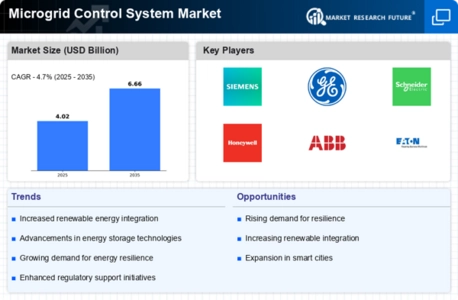Rising Demand for Energy Resilience
The increasing demand for energy resilience is a pivotal driver in the Microgrid Control System Market. As communities and industries face the challenges of energy supply disruptions, the need for reliable and resilient energy systems becomes paramount. Microgrids offer localized energy solutions that can operate independently or in conjunction with the main grid, thereby enhancing energy security. According to recent data, the microgrid market is projected to grow at a compound annual growth rate of over 12% through the next few years, indicating a robust demand for systems that ensure uninterrupted power supply. This trend is particularly evident in regions prone to natural disasters, where microgrid control systems can provide critical support during emergencies.
Increased Investment in Smart Grid Technologies
Investment in smart grid technologies is significantly influencing the Microgrid Control System Market. As utilities and governments prioritize modernization of energy infrastructure, the integration of smart technologies into microgrid systems is becoming increasingly prevalent. These technologies facilitate real-time monitoring, data analytics, and automated control, which enhance the efficiency and reliability of energy distribution. Recent reports suggest that investments in smart grid technologies are expected to exceed $100 billion by 2026, underscoring the financial commitment to advancing microgrid capabilities. This influx of capital is likely to accelerate the development and deployment of innovative microgrid control systems, thereby expanding their market presence.
Supportive Regulatory Frameworks and Incentives
Supportive regulatory frameworks and incentives are driving growth in the Microgrid Control System Market. Governments worldwide are increasingly recognizing the benefits of microgrids in enhancing energy security and promoting renewable energy adoption. Various policies, including tax incentives, grants, and streamlined permitting processes, are being implemented to encourage the development of microgrid projects. For instance, recent legislation in several regions has allocated substantial funding for microgrid initiatives, which is expected to catalyze market growth. This regulatory support not only fosters innovation but also attracts private investment, creating a favorable environment for the expansion of microgrid control systems.
Growing Focus on Sustainability and Carbon Reduction
The growing focus on sustainability and carbon reduction is a crucial driver for the Microgrid Control System Market. As nations strive to meet ambitious climate goals, the transition to cleaner energy sources is becoming a priority. Microgrids, which often incorporate renewable energy sources such as solar and wind, play a vital role in this transition. The International Energy Agency has indicated that renewable energy could account for over 50% of the global energy mix by 2030, further emphasizing the importance of microgrid systems in achieving these targets. This shift not only supports environmental objectives but also enhances energy independence, making microgrid control systems an attractive solution for both public and private sectors.
Technological Advancements in Energy Storage Solutions
Technological advancements in energy storage solutions are significantly impacting the Microgrid Control System Market. The development of more efficient and cost-effective energy storage technologies, such as lithium-ion batteries and flow batteries, is enabling microgrids to store excess energy generated from renewable sources. This capability is essential for balancing supply and demand, particularly during peak usage times. As energy storage technologies continue to evolve, the market for microgrid control systems is expected to expand, with projections indicating a potential growth rate of 15% annually in the energy storage sector. This synergy between microgrid systems and advanced storage solutions is likely to enhance the overall performance and reliability of energy networks.



.webp)
.webp)
.webp)
.webp)
.webp)
.webp)








Leave a Comment